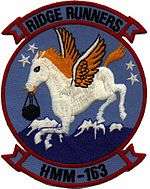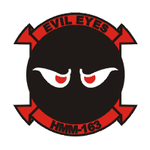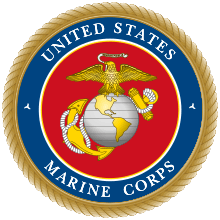VMM-163
Marine Medium Tiltrotor Squadron 163 (VMM-163) is a United States Marine Corps helicopter squadron consisting of MV-22 Osprey transport tiltrotors. The squadron, known as the "Ridge Runners", is based at Marine Corps Air Station Miramar, California and falls under the command of Marine Aircraft Group 16 (MAG-16) and the 3rd Marine Aircraft Wing (3rd MAW).
| Marine Medium Tiltrotor Squadron 163 | |
|---|---|
 Old HMM-163 Insignia | |
| Active | December 1951 - present |
| Country | United States |
| Allegiance | United States of America |
| Branch | United States Marine Corps |
| Type | Medium Lift Tiltrotor Squadron |
| Role | Assault Support |
| Part of | Marine Aircraft Group 16 3rd Marine Aircraft Wing |
| Garrison/HQ | Marine Corps Air Station Miramar |
| Nickname(s) | "Ridge Runners" "Evil Eyes" |
| Tail Code | YP |
| Engagements | Vietnam War * Battle of A Shau Operation Enduring Freedom Operation Iraqi Freedom |
| Commanders | |
| Current commander | LtCol Andrew J. Norris |
The Squadron's nickname, "Ridge Runners", was bestowed as a result of typhoon rescue and relief operations in the mountainous terrain surrounding Hagman, Japan.
Mission
Provide assault support transport of combat troops, supplies and equipment during expeditionary, joint or combined operations. Be prepared for short-notice, worldwide deployment in support of Marine Air-Ground Task Force operations.
History
Vietnam War
HMR(L)-163, the predecessor of HMM-163, was formed in December 1951. From February to October 1965, the HMM-163 "Ridge Runners" helicopter squadron became famous for its operations in Vietnam. This was primarily due to a LIFE magazine photo-essay by Larry Burrows "One ride with Yankee Papa 13" that documented the combat death of Marine H-34 pilot 1st Lt James E. Magel and the rescue of wounded gunner Sgt Billie Owens during a mission transporting Army of the Republic of Vietnam (ARVN) troops near Danang on 31 March 1965.[1] For most U.S. citizens, this was the first time they were made aware of the extent of America's involvement in Vietnam.
In late October 1965, HMM-163 relocated to Marine Corps Air Station Futenma in Okinawa, Japan. Capt Al Barbes, the Squadron Intelligence Officer and husband to a Filipina bride, offered a suggestion. Because of Asian culture and beliefs, he proposed that eyes painted on the unit aircraft might have an unsettling effect upon the enemy, thus the concept of "The Eyes" on the front of HMM-163 aircraft was born.
On January 1, 1966, HMM-163 flew by C-130 to Phu Bai, Vietnam, relieved HMM-161, and took over all their H-34 helicopters. Painting of what were then called "Genie Eyes" (after the "I Dream of Jeannie" TV show) began immediately. By March 1966, HMM-163's "Genie Eyes" were being called "Evil Eyes" by the ground units supported.
On March 9, 1966, the 95th Regiment of the People's Army of Vietnam (PAVN) 325th Division attacked the Special Forces camp in the A Shau Valley about 30 miles (50 km) southwest of Hue in Thua Thien Province. It was strategically important for the PAVN as a major infiltration route because it was adjacent to the Ho Chi Minh Trail. Defending the camp were 10 Green Berets and 210 South Vietnamese Civilian Irregular Defense Group, supported by Air Commando units equipped with vintage A-1 Skyraiders and AC-47 Spooky gunships. The squadron flew over 2,000 flight hours in ten days during the battle in which 190 survivors were rescued from enemy capture. They did this in the face of heavy enemy anti-aircraft fire. During the battle, 21 of the 24 aircraft assigned to the squadron suffered "major damage" including the two that were shot down.[2]
In October 1966, the squadron again returned to Phu Bai, still with black and white "Evil Eyes", under the command of LtCol Otto Bianchi. LtCol Bianchi was a good friend of the Wing Commander, but that didn't keep Major General Louis Robertshaw, 1st MAW Commanding General, from reading LtCol Bianchi the "riot act" concerning the unauthorized paint scheme. Also in the room at the time of this conversation was the Commanding General of the Marine ground forces in the area, who politely interrupted by saying, "It sure is great to have the 'Evil Eyes' back here at Phu Bai!" The 1st MAW Commanding General relented and the "Evil Eyes" have remained to this day. The squadron remained in Vietnam until August 1968.
1990s
During the 1990s, HMM-163 continued to excel while serving as the Aviation Combat Element (ACE) for five Special Operations Capable Marine Expeditionary Units (MEU(SOC)) on deployments to the Pacific and Central Command theaters. During this time, the squadron participated in operations across the Pacific and from the Horn of Africa to the Persian Gulf, including Operation Fiery Vigil in 1991, Operation Continue Hope, Operation Distant Runner, and Operation Quick Draw in 1994, Operation Desert Strike in 1996 and Operation Resolute Response in 1998.
Global War on Terror

In 2001, while deployed with the 15th Marine Expeditionary Unit(SOC), the Evil Eyes of HMM-163 again had the opportunity to serve America with distinction by participating in combat operations in support of Operation Enduring Freedom. While forward deployed to the Central Command Theater of Operations, the Evil Eyes planned and executed the longest amphibious assault in American military history with the seizure of a Forward Operating Base (FOB) in southern Afghanistan. This was accomplished through the use of a 4-aircraft detachment of CH-53E helicopters, which are capable of in-flight refueling. They had been attached to the squadron 8 months earlier in preparation for deployment as the Air Combat Element of the 15th MEU (SOC). The squadron remained forward deployed for seven weeks operating from the austere base in support of Task Force 58 and other coalition Special Operations Forces.
In 2003, the Evil Eyes deployed from August 22, 2003 to March 8, 2004 with the 13th Marine Expeditionary Unit. Again, the squadron made history by being part of the first Expeditionary Strike Group One (ESG-1). The ESG concept focused on combining surface action groups and submarines with traditional Amphibious Ready Groups (ARGs) and MEUs to offer theater combatant commanders more flexibility and capabilities. During this deployment HMM-163 participated in security operation in the southern Iraqi city of Basrah in support of Operation Iraqi Freedom.
Awards
- HMM-163 received the Chief of Naval Operations Aviation Safety Awards in 1980, 1982, 1983, 1984, 1985, 1989, and 1996.
- Meritorious Unit Commendations (MUC) with one Gold Star
- Named the MCAA Helicopter squadron of the Year in 1979, 1981, 1985, 1990, and 2002.
Gallery
_off_Korea_on_2_September_1952.jpg) An HMR-163 HUS-2 over USS Sicily (CVE-118), 1952.
An HMR-163 HUS-2 over USS Sicily (CVE-118), 1952.- A UH-34D from HMM-163 over Vietnam, 1967.
 Vietnam-era squadron insignia.
Vietnam-era squadron insignia.- A CH-46E from HMM-163, in 1989.
_provides_support_during_the_Air_show's_Marine_Air-ground_Task_Force_(MA.jpg) CH-46Es from HMM-163, in 2005.
CH-46Es from HMM-163, in 2005.
See also
- List of United States Marine Corps aircraft squadrons
- United States Marine Corps Aviation
References

Citations
- Burrows, Larry. "One Ride with YP-13", Life Magazine, April 1965. (photo essay)
- Sturkey, Bonnie-Sue, pp. 18–23.
Bibliography
- Sturkey, Marion F. (1997). BONNIE-SUE: A Marine Corps Helicopter Squadron in Vietnam. Heritage Press International. ISBN 0-9650814-2-7.

